South Carolina is facing an urgent public health challenge as a significant measles outbreak grips the Upstate region. This highly contagious virus has led to over 150 unvaccinated children being placed under a mandatory 21-day quarantine, sparking widespread concern. The situation highlights a alarming national trend: a resurgence of measles, decades after its elimination in the US. This article delves into the specifics of the South Carolina outbreak, the critical role of declining vaccination rates, and the broader implications for community health nationwide.
South Carolina Confronts a Spreading Measles Crisis
Health officials in South Carolina are actively battling a concerning measles outbreak, with warnings of undetected community spread in the state’s northern Upstate region. Specifically, Spartanburg and Greenville counties are at the epicenter. Since September 25, at least seven confirmed measles cases have been identified in Spartanburg. Transmission has occurred within two local schools: Fairforest Elementary and Global Academy, a public charter school.
An eighth potential case recently emerged in Greenville. This indicates active, unrecognized community transmission of measles. State epidemiologist Dr. Linda Bell has explicitly warned of this hidden spread. Officials are urging immediate public attention to vaccination status.
Over 150 Students Quarantined
As a direct consequence of these school exposures, a staggering 153 unvaccinated children from the two Spartanburg schools have been ordered into a 21-day quarantine. During this period, these students are strictly prohibited from attending school. This measure is crucial because 21 days represents the maximum incubation period for the highly infectious measles virus. It ensures the disease’s transmission window has passed before potential re-entry into the community. The South Carolina Department of Public Health emphasizes this protective measure is for community safety, not punitive.
The quarantine orders apply to students who either haven’t received the measles, mumps, and rubella (MMR) vaccine or lack proof of immunity. These children are now engaging in remote learning. This incident underscores the significant societal burden when community vaccination rates fall below protective levels, forcing extensive public health interventions.
Measles: A Potent and Pernicious Threat
Measles is one of the most contagious diseases known to humanity. Without protection, a staggering 90% of unvaccinated individuals exposed to the virus will contract the infection. The virus spreads easily through the air. Its infectious particles can linger in the airspace of a room for up to two hours after an infected person has left. This remarkable airborne persistence contributes to its rapid spread.
One infected individual can transmit the virus to as many as 18 other unvaccinated people. Before widespread vaccination, nearly everyone contracted measles in childhood. This led to hundreds of deaths annually in the U.S. While the virus was declared eliminated in the U.S. in 2000, recent declines in vaccination coverage have allowed it to regain a foothold.
The Lifelong Protection of the MMR Vaccine
The measles, mumps, and rubella (MMR) vaccine offers robust and enduring protection. Two recommended doses are approximately 97% effective at blocking the infection. This protection is considered lifelong. Even one dose provides about 93% protection. This vaccine has been a cornerstone of public health, preventing severe complications. Measles can lead to serious health issues, including pneumonia, brain inflammation, deafness, and even death. Tragically, three people, including two previously healthy school-aged children, have already died from measles in the U.S. this year. Approximately one in eight measles cases require hospitalization.
Declining Vaccination Rates Fuel the Outbreak
A primary factor driving the current measles outbreak in South Carolina and its associated quarantines is the alarming decline in local and national vaccination rates. Health experts recommend a 95% vaccination threshold for achieving herd immunity. This level of community protection prevents widespread outbreaks. However, many areas, including those affected in South Carolina, are falling short.
In the 2024–2025 school year, Spartanburg County reported an immunization rate of just 90%. Greenville County’s rate was 92.4%. Both figures are well below the target 95% needed for effective community protection. Spartanburg notably has the highest rate of religious vaccination exemptions among students in South Carolina, at 8.2%. This limits its maximum vaccine coverage to 91.8%, even if all other students were vaccinated. Greenville’s religious exemption rate is 5.3%, with a maximum coverage of 94.7%.
A Worrying National Trend
These local trends mirror broader state and national patterns. Over the past five years, South Carolina’s overall vaccination rates have slipped from over 95% to 93.7%. Concurrently, religious exemptions have risen significantly, from less than 1% a decade ago to 3.3% statewide. This unfortunate shift has played out across the country. Anti-vaccine rhetoric, misinformation, and disinformation have taken root, eroding public confidence in established health practices.
Nationally, MMR vaccination coverage for U.S. kindergartners dropped to just 92.5% in the 2024–2025 school year. This is a noticeable decline from 95.2% in 2019–2020. Non-medical exemptions for vaccinations across the country have now reached an all-time high of 3.4%. These “pockets of opportunity,” as described by pediatric infectious disease specialists, allow measles to spread rapidly when introduced into under-vaccinated communities.
The Resurgence: Highest U.S. Measles Cases in 33 Years
The current situation in South Carolina is part of a much larger, disturbing trend across the United States. The nation is experiencing its highest measles case count in 33 years. The Centers for Disease Control and Prevention (CDC) has tallied 1,563 confirmed cases from 41 states this year. However, some experts like Dr. Paul Offit from the Children’s Hospital of Philadelphia suggest the true figure could be substantially higher, possibly closer to 5,000.
Most of these cases are linked to 44 identified outbreaks across the country. The largest so far occurred in Texas, which reported 803 cases this year. Other significant outbreaks are ongoing in Arizona, Utah, and Minnesota. In Utah, wastewater testing indicates a broader spread of the virus than initially known. The return of measles, a disease once considered eliminated, serves as a stark reminder of the vulnerability of communities with insufficient herd immunity.
The Impact of Misinformation and Political Influence
The rise in vaccine hesitancy and the subsequent decline in vaccination rates are inextricably linked to the spread of misinformation and disinformation, particularly online. This skepticism, exacerbated by responses to the COVID-19 pandemic, has created fertile ground for vaccine-preventable diseases to re-emerge.
Adding to the complexity are controversial statements from political figures that run counter to established medical advice. Jim O’Neill, Acting Director of the CDC and Deputy Health and Human Services Secretary under Robert F. Kennedy Jr., has publicly supported administering the MMR vaccine as three separate shots. This idea lacks scientific justification and is opposed by inoculation experts. Major pharmaceutical manufacturers, such as Merck, caution against this approach. Separating the vaccine would necessitate more injections for children, increasing disruptions to immunization schedules and potentially encouraging further viral spread. Such messaging contributes to parental confusion and vaccine hesitancy, making public health efforts more challenging.
Protecting Our Communities: A Call to Action
The measles outbreak in South Carolina and the broader national resurgence demand immediate and collective action. Public health officials are emphasizing the critical need for vaccination to stem the tide of community transmission. Protecting our communities hinges on achieving and maintaining high vaccination rates.
Families in affected areas and nationwide should verify their MMR vaccination status. If unsure or unvaccinated, consult with a healthcare provider. The MMR vaccine remains the most effective method for protecting individuals and the wider community from this serious, preventable disease. Education and clear, consistent public health messaging are vital to counter misinformation. A renewed commitment to vaccination is the cornerstone of preventing further outbreaks and safeguarding public health.
Frequently Asked Questions
What caused the recent measles outbreak and quarantine in South Carolina?
The recent measles outbreak in South Carolina’s Upstate region (Spartanburg and Greenville counties) is primarily linked to declining vaccination rates below the 95% threshold needed for herd immunity. Specifically, Spartanburg’s school immunization rate is 90%, with an 8.2% religious exemption rate. The outbreak resulted in 153 unvaccinated children being quarantined for 21 days after exposure in schools like Fairforest Elementary and Global Academy. Health officials confirm active, unrecognized community transmission.
How dangerous is measles, and how effective is the MMR vaccine against it?
Measles is extremely dangerous and highly contagious. It can infect 90% of unvaccinated people exposed, lingering in the air for up to two hours. Complications can include pneumonia, brain inflammation, deafness, and even death. The MMR vaccine is highly effective: two doses provide about 97% lifelong protection against measles. This level of protection is crucial for preventing severe outcomes and community spread.
What can parents and communities do to prevent future measles outbreaks?
To prevent future measles outbreaks, parents should ensure their children receive both recommended doses of the MMR vaccine. Communities must aim for at least a 95% vaccination rate to achieve herd immunity. It is also vital to counter misinformation with accurate health information and support public health guidelines. Checking vaccination records and consulting healthcare providers for guidance are important proactive steps.
Conclusion
The ongoing measles outbreak in South Carolina, leading to the quarantine of over 150 unvaccinated children, serves as a stark warning. It is a tangible consequence of declining vaccination rates and the spread of misinformation. This local crisis mirrors a worrying national trend, with the U.S. experiencing its highest measles caseload in over three decades. The resurgence of this once-eliminated disease underscores the fragile nature of public health achievements when collective immunity falters. Protecting our children and communities requires a renewed commitment to vaccination, informed decision-making, and trust in scientific consensus. Each decision to vaccinate reinforces the protective shield that keeps these preventable diseases at bay.



